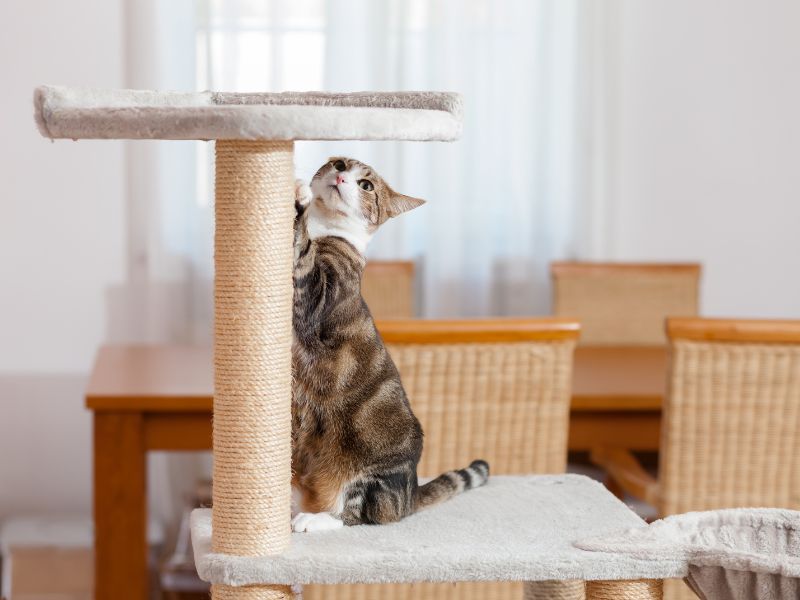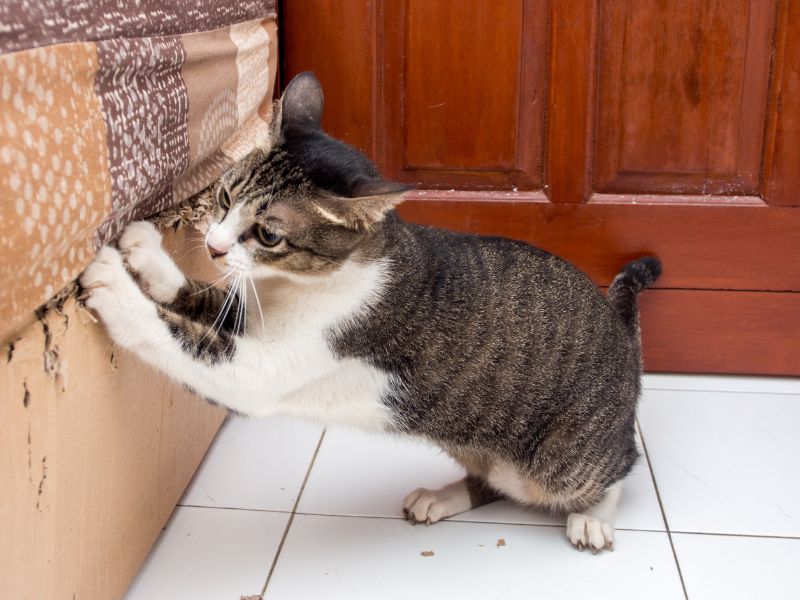It can be the bane of a cat owners’ life when your cat starts scratching your furniture and carpets. The cat doesn’t set out to destroy your fixtures and fittings, but it can be costly to repair or replace the damaged items. Please don’t discipline or chastise your cat for doing this though, it is not deliberate vandalism or evil mischievousness. Thankfully, your pet can be taught other, better habits, for there are some simple and easy ways to stop your cat from scratching your furniture and carpets.
Why Do Cats Scratch?
Cats are instinctive hunters, armed with claws and teeth. To hunt effectively and efficiently they have to keep their claws in tip-top condition. Therefore, cats scratch to keep their claws healthy and sharp so they are fit for purpose if they ever have to hunt. Even house cats, who never have the chance to hunt, will scratch to keep their claws healthy. Cats can also mark their territory by scratching, and this is why quite often, they will target furniture and carpets in the home.
As well as being instinctive behavior, cats may also scratch because they are stressed or bored, or have to relieve tension. Your cat may express itself by scratching if it is not getting enough stimulation in the home.

How Do I Deter My Cat from Scratching Furniture and Carpets?
There are a wide range of commercially available scratching posts. From a basic single upright pole, to more complicated boxy structures that stretch from floor to almost ceiling height. Depending on the space you have, and the budget you have available, this may dictate what kind of a scratching post you can purchase. Buy the best you can afford, and have the space for. The more elaborate they are, the more opportunities they can provide to stimulate your cat with exercise and play, and give your cat a variety of surfaces to scratch, hopefully then leaving your furniture and carpets alone.
It is advisable to position your scratching post near to where the cat has been scratching furniture or damaging carpets. When the cat has an area at hand it can readily scratch and be rewarded for doing so, it should leave your furniture alone. You can further encourage your cat to use the scratching post by subtly leaving a few treats in or around it.
To encourage your cat more to use your new scratching post, you can purchase cat deterrent spray or scents to apply on areas of furniture and carpets that the cat has damaged before. With application, cats will now find these areas far less appealing and may well avoid them altogether.
Scratch tape is another option available. This kind of tape is designed to be unappealing to cats, made from a material they don’t like. Apply the tape to areas the cat has damaged. The cat may scratch it off, but it is relatively safe. You may need to reapply the tape periodically if the cat is persistently scratching that area, but hopefully, if the cat is distracted enough by a legitimate scratching post, it will soon forget about that area entirely.

See Also: Do All Domestic Cats Have Retractable Claws?
And: How Cats Can Help Control Rodent Infestations
Rewards and positive reinforcement
You can further protect your furniture and carpets from damage by rewards and positive reinforcement. Deter your cat from your furniture by distracting it and redirecting its attention to your scratching post. You can reward your cat with treats and verbal praise and encouragement when successful. Play with your cat when it uses the scratching post to further stimulate it and distract it from boredom. This way it will associate the scratching post with rewards and play. Playtime with your cat is also a great way to strengthen the bond between you and your cat.
Conclusion
Damage to furniture and carpets can be frustrating for cat owners. The more expensive these household items are, the more, especially a new cat owner, may begrudge the cat, and begin to regret being a cat owner at all. It is important to know though, that the cat is not damaging your furnishings on purpose, it is just keeping itself fit and healthy in the ways it thinks best.
Fortunately, the damage inflicted may not be a permanent state of affairs you have to grow used too. You can combat your cat’s vandalism by following some basic simple steps as outlined above. Buying a good scratching post and creating a legitimate area for your cat to scratch, and using deterrents such as scents or sprays and/or scratch tape, can help save your furniture and carpets.
Praise, positive reinforcement, and treats, can make a difference as also, as well as creating a greater bond between yourself and the cat. Hopefully, with the right combination of these methods, you can teach your cat to only use the scratch post, and leave your furniture and carpets alone.

